Vibration Energy Comparison Helps Identify Formation Time of New Free Surface in Urban Tunnel Blasting
Abstract
1. Introduction
2. Materials and Methods
2.1. Fundamentals of Linear Superposition Method and Parameter Selection Method
2.2. Problem of Linear Superposition Method and Solutions
2.3. Vibration Energy Comparison Method
3. Results
3.1. Engineering Background and Challenges
3.2. Identification of New-Free-Surface Formation Time
3.3. Selection of Charge Amount per Hole
3.4. Application on Site
4. Conclusions
- (1)
- A vibration-prediction method that considered the action of the newly created free surface during blasting was proposed. The crucial step was to determine the formation time of the new free surface by comparing the vibration energy. The specific process combined the detonator sample test of each delay with the VMD method so the exact initiation time sequence of each delay could be determined in the observed blast vibration wave. The predicted wave with the same initiation time sequence was constructed using the linear superposition method. The Hilbert transform then found the accumulated energy curves of the observed and predicted the vibration waves. The new-free-surface formation time was found by comparing the linear correlation of the two curves.
- (2)
- The formation time of the new free surface was determined to be 64.5 ms through the case study, while the change in rock conditions around the blast hole caused by its action could last up to 91.375 ms. For this reason, the applicable range of the linear superposition model for predicting the superposed vibration velocity was determined to be the first three blast holes. The maximum vibration peaks that could be achieved by using 1.0 kg and 1.2 kg in a single-hole charge were 0.775 cm-s−1 and 0.868 cm-s−1, respectively, under a vibration velocity threshold of 1.0 cm-s−1. Considering that the actual range of the detonator’s delay error may have been larger and due to the superposed effect of vibration caused by subsequent holes, a single-hole charge of 1.0 kg was finally used to ensure blasting safety.
- (3)
- There is great potential for solving complex blast calculation problems through the rapid development of computer technology. Since NONEL detonators have a wide range of delay errors, using their nominal initiation times to calculate superposed waves is simple but can result in significant errors. If the enumeration method traverses all possible initiation time groups, it will consume a lot of time. This paper used the Monte Carlo method to simulate the randomness of detonations, which saved computing time and accurately obtained the maximum superposed vibration velocity value. The blasting results in the field showed that the selected charge could meet the requirements for low-vibration velocity control.
Author Contributions
Funding
Institutional Review Board Statement
Informed Consent Statement
Data Availability Statement
Acknowledgments
Conflicts of Interest
References
- Verma, H.; Samadhiya, N.; Singh, M.; Goel, R.; Singh, P. Blast induced rock mass damage around tunnels. Tunn. Undergr. Space Technol. 2018, 71, 149–158. [Google Scholar] [CrossRef]
- Qu, S.; Yang, J.; Zhu, S.; Zhai, W.; Kouroussis, G.; Zhang, Q. Experimental study on ground vibration induced by double-line subway trains and road traffic. Transp. Geotech. 2021, 29, 100564. [Google Scholar] [CrossRef]
- Agrawal, H.; Mishra, A. Probabilistic analysis on scattering effect of initiation systems and concept of modified charge per delay for prediction of blast induced ground vibrations. Measurement 2018, 130, 306–317. [Google Scholar] [CrossRef]
- Ding, Z.; Nguyen, H.; Bui, X.-N.; Zhou, J.; Moayedi, H. Computational Intelligence Model for Estimating Intensity of Blast-Induced Ground Vibration in a Mine Based on Imperialist Competitive and Extreme Gradient Boosting Algorithms. Nat. Resour. Res. 2020, 29, 751–769. [Google Scholar] [CrossRef]
- Yan, Y.; Hou, X.; Fei, H. Review of predicting the blast-induced ground vibrations to reduce impacts on ambient urban communities. J. Clean. Prod. 2020, 260, 121135. [Google Scholar] [CrossRef]
- Yang, J.; Cai, J.; Yao, C.; Li, P.; Jiang, Q.; Zhou, C. Comparative Study of Tunnel Blast-Induced Vibration on Tunnel Surfaces and Inside Surrounding Rock. Rock Mech. Rock Eng. 2019, 52, 4747–4761. [Google Scholar] [CrossRef]
- Jayasinghe, B.; Zhao, Z.; Chee, A.G.T.; Zhou, H.; Gui, Y. Attenuation of rock blasting induced ground vibration in rock-soil interface. J. Rock Mech. Geotech. Eng. 2019, 11, 770–778. [Google Scholar] [CrossRef]
- Zeng, Y.; Li, H.; Xia, X.; Liu, B.; Zuo, H.; Jiang, J. Blast-induced rock damage control in Fangchenggang nuclear power station, China. J. Rock Mech. Geotech. Eng. 2018, 10, 914–923. [Google Scholar] [CrossRef]
- Sharafat, A.; Tanoli, W.A.; Raptis, G.; Seo, J.W. Controlled blasting in underground construction: A case study of a tunnel plug demolition in the Neelum Jhelum hydroelectric project. Tunn. Undergr. Space Technol. 2019, 93, 103098. [Google Scholar] [CrossRef]
- Matidza, M.I.; Jianhua, Z.; Gang, H.; Mwangi, A.D. Assessment of Blast-Induced Ground Vibration at Jinduicheng Molybdenum Open Pit Mine. Nat. Resour. Res. 2020, 29, 831–841. [Google Scholar] [CrossRef]
- Ainalis, D.; Kaufmann, O.; Tshibangu, J.-P.; Verlinden, O.; Kouroussis, G. Modelling the Source of Blasting for the Numerical Simulation of Blast-Induced Ground Vibrations: A Review. Rock Mech. Rock Eng. 2017, 50, 171–193. [Google Scholar] [CrossRef]
- Azizabadi, H.R.M.; Mansouri, H.; Fouché, O. Coupling of two methods, waveform superposition and numerical, to model blast vibration effect on slope stability in jointed rock masses. Comput. Geotech. 2014, 61, 42–49. [Google Scholar] [CrossRef]
- Liu, J.; Zhang, Y.; Yun, B. A new method for predicting nonlinear structural vibrations induced by ground impact loading. J. Sound Vib. 2012, 331, 2129–2140. [Google Scholar] [CrossRef]
- Agrawal, H.; Mishra, A.K. An innovative technique of simplified signature hole analysis for prediction of blast-induced ground vibration of multi-hole/production blast: An empirical analysis. Nat. Hazards 2020, 100, 111–132. [Google Scholar] [CrossRef]
- Zhang, H.; Li, T.; Wu, S.; Zhang, X.; Gao, W.; Shi, Q. A study of innovative cut blasting for rock roadway excavation based on numerical simulation and field tests. Tunn. Undergr. Space Technol. 2021, 119, 104233. [Google Scholar] [CrossRef]
- Chandrakar, S.; Paul, P.; Sawmliana, C. Influence of void ratio on “Blast Pull” for different confinement factors of development headings in underground metalliferous mines. Tunn. Undergr. Space Technol. 2020, 108, 103716. [Google Scholar] [CrossRef]
- Tian, X.; Song, Z.; Wang, J. Study on the propagation law of tunnel blasting vibration in stratum and blasting vibration reduction technology. Soil Dyn. Earthq. Eng. 2019, 126, 105813. [Google Scholar] [CrossRef]
- Yang, J.H.; Lu, W.B.; Jiang, Q.H.; Yao, C.; Zhou, C.B. Frequency comparison of blast-induced vibration per delay for the full-face millisecond delay blasting in underground opening excavation. Tunn. Undergr. Space Technol. 2016, 51, 189–201. [Google Scholar] [CrossRef]
- Zhang, Z.X.; Hou, D.F.; Guo, Z.; He, Z.; Zhang, Q. Experimental study of surface constraint effect on rock fragmentation by blasting. Int. J. Rock Mech. Min. Sci. 2020, 128, 104278. [Google Scholar] [CrossRef]
- Huo, X.; Shi, X.; Qiu, X.; Chen, H.; Zhou, J.; Zhang, S.; Rao, D. Study on Rock Damage Mechanism for Lateral Blasting under High In Situ Stresses. Appl. Sci. 2021, 11, 4992. [Google Scholar] [CrossRef]
- Qiu, X.; Shi, X.; Gou, Y.; Zhou, J.; Chen, H.; Huo, X. Short-delay blasting with single free surface: Results of experimental tests. Tunn. Undergr. Space Technol. 2018, 74, 119–130. [Google Scholar] [CrossRef]
- Blair, D. The free surface influence on blast vibration. Int. J. Rock Mech. Min. Sci. 2015, 77, 182–191. [Google Scholar] [CrossRef]
- Dragomiretskiy, K.; Zosso, D. Variational Mode Decomposition. IEEE Trans. Signal Process. 2013, 62, 531–544. [Google Scholar] [CrossRef]
- Shi, X.-Z.; Qiu, X.-Y.; Zhou, J.; Chen, X.; Fan, Y.-Q.; Lu, E.-W. Application of Hilbert-Huang transform based delay time identification in optimization of short millisecond blasting. Trans. Nonferrous Met. Soc. China 2016, 26, 1965–1974. [Google Scholar] [CrossRef]
- Wang, Z.; Fang, C.; Chen, Y.; Cheng, W. A comparative study of delay time identification by vibration energy analysis in millisecond blasting. Int. J. Rock Mech. Min. Sci. 2013, 60, 389–400. [Google Scholar] [CrossRef]
- Wu, H.; Gong, M. Calculation and application of hole by hole blasting vibration superposition based on measured delay times of detonators. Explos. Shock. Waves 2019, 39, 151–161. (In Chinese) [Google Scholar] [CrossRef]

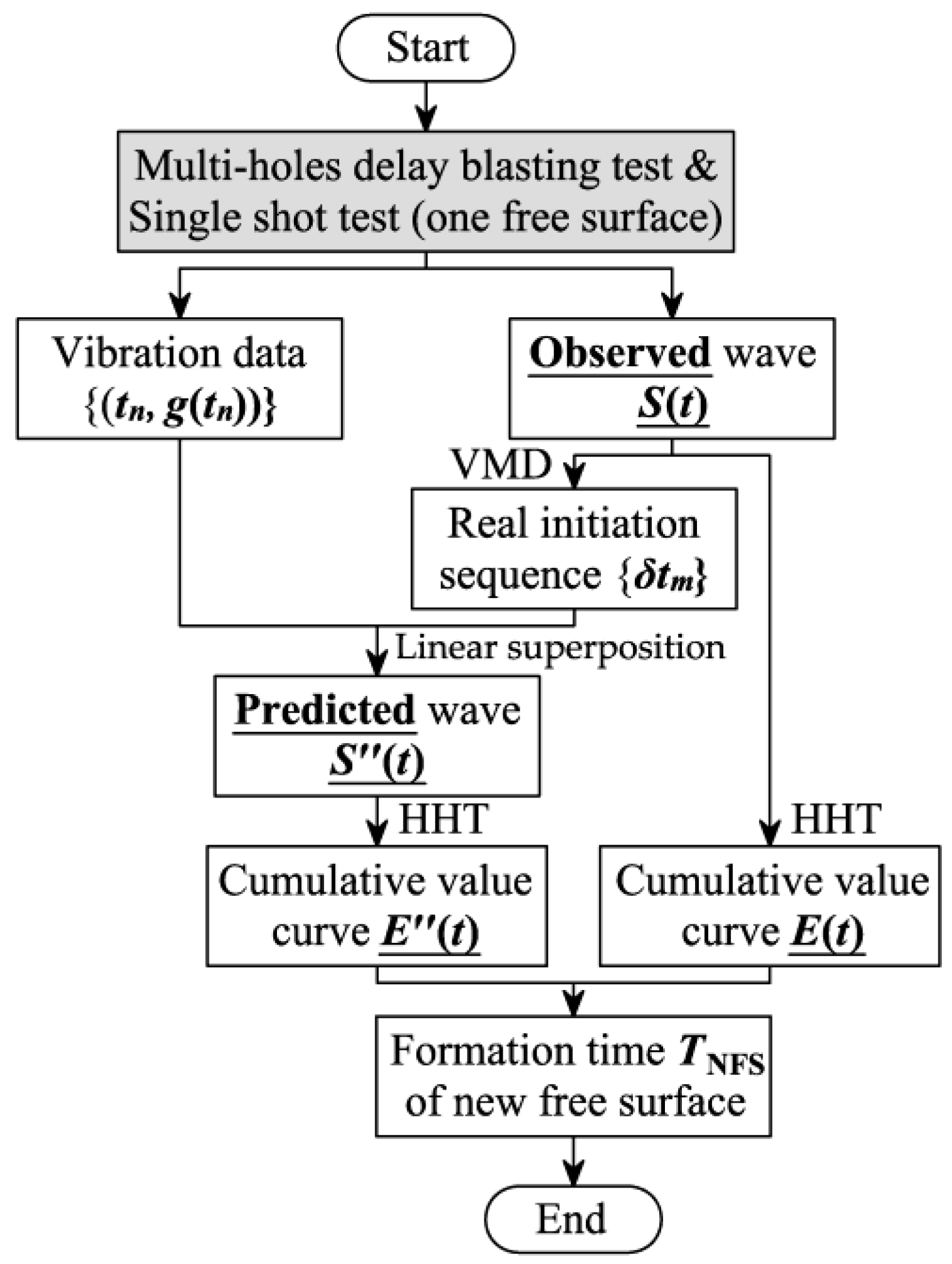

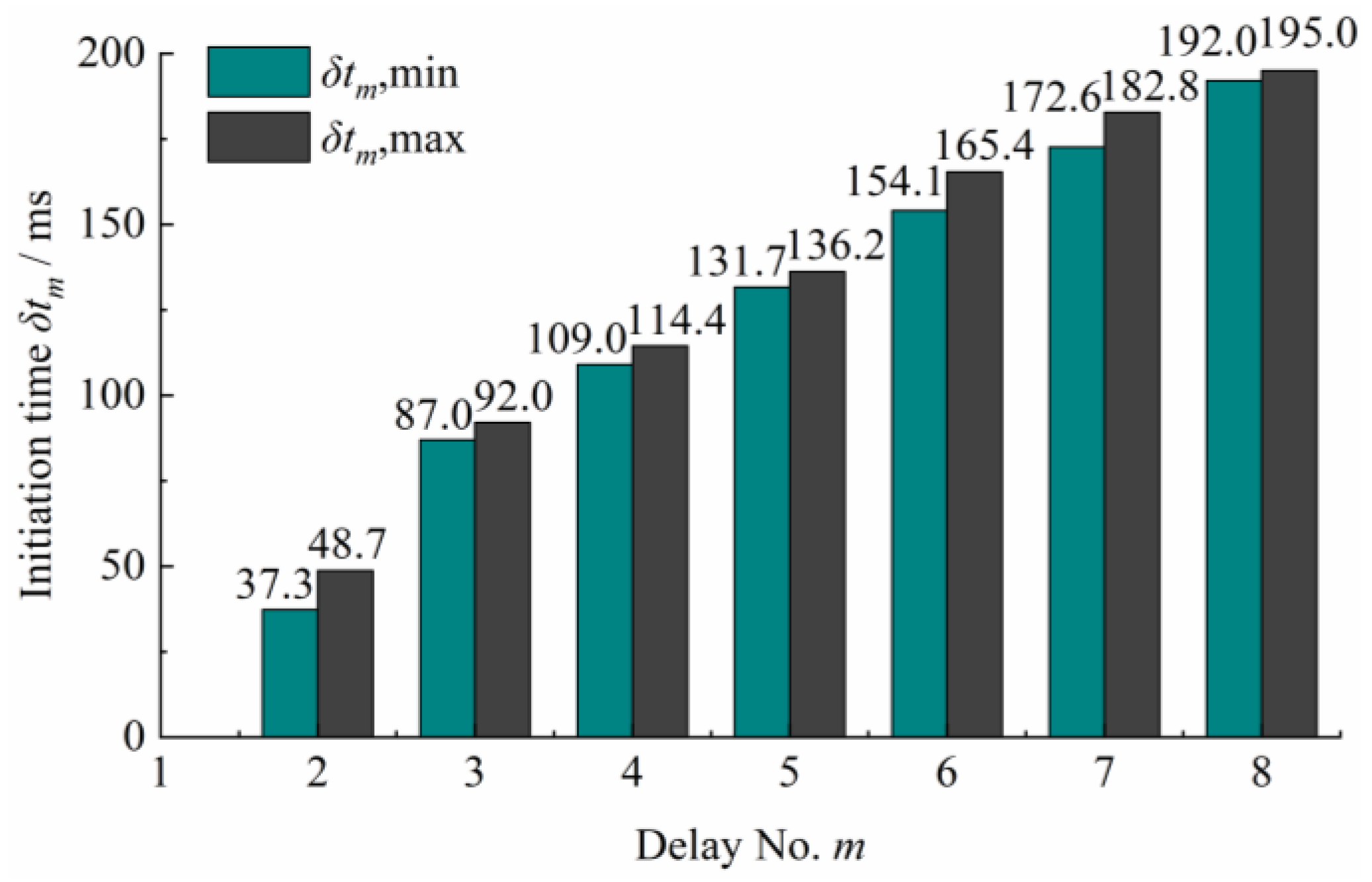
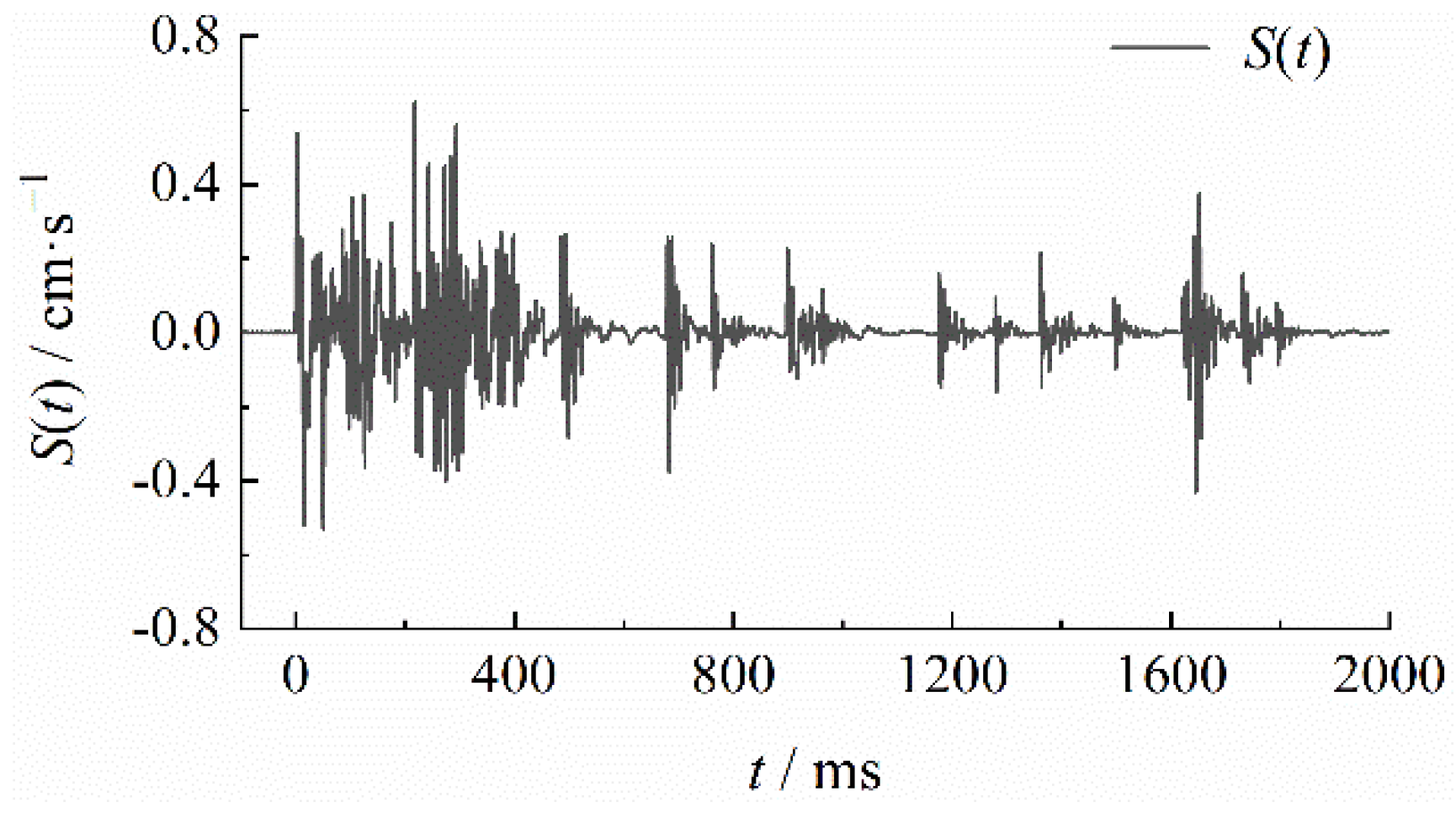
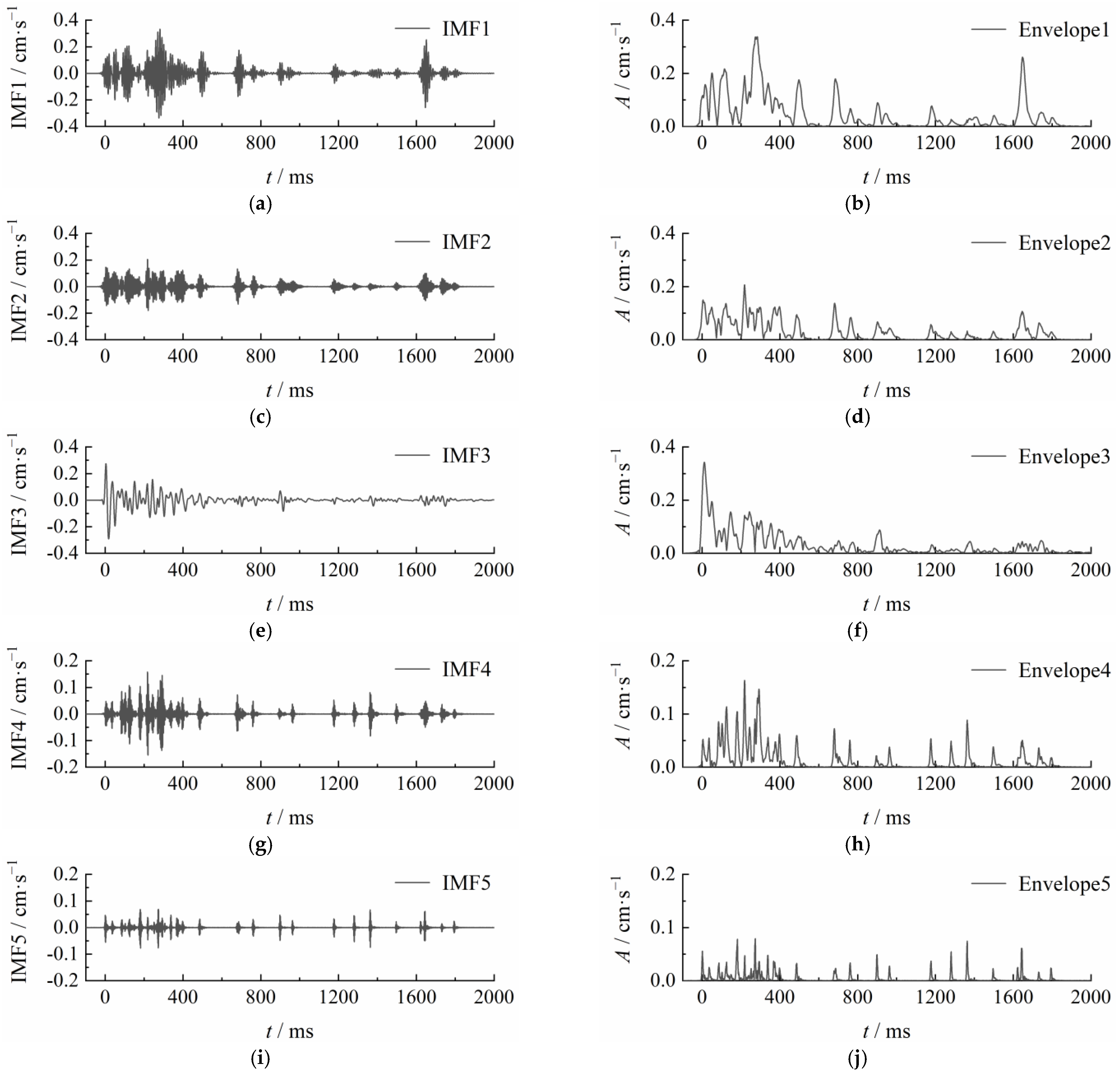
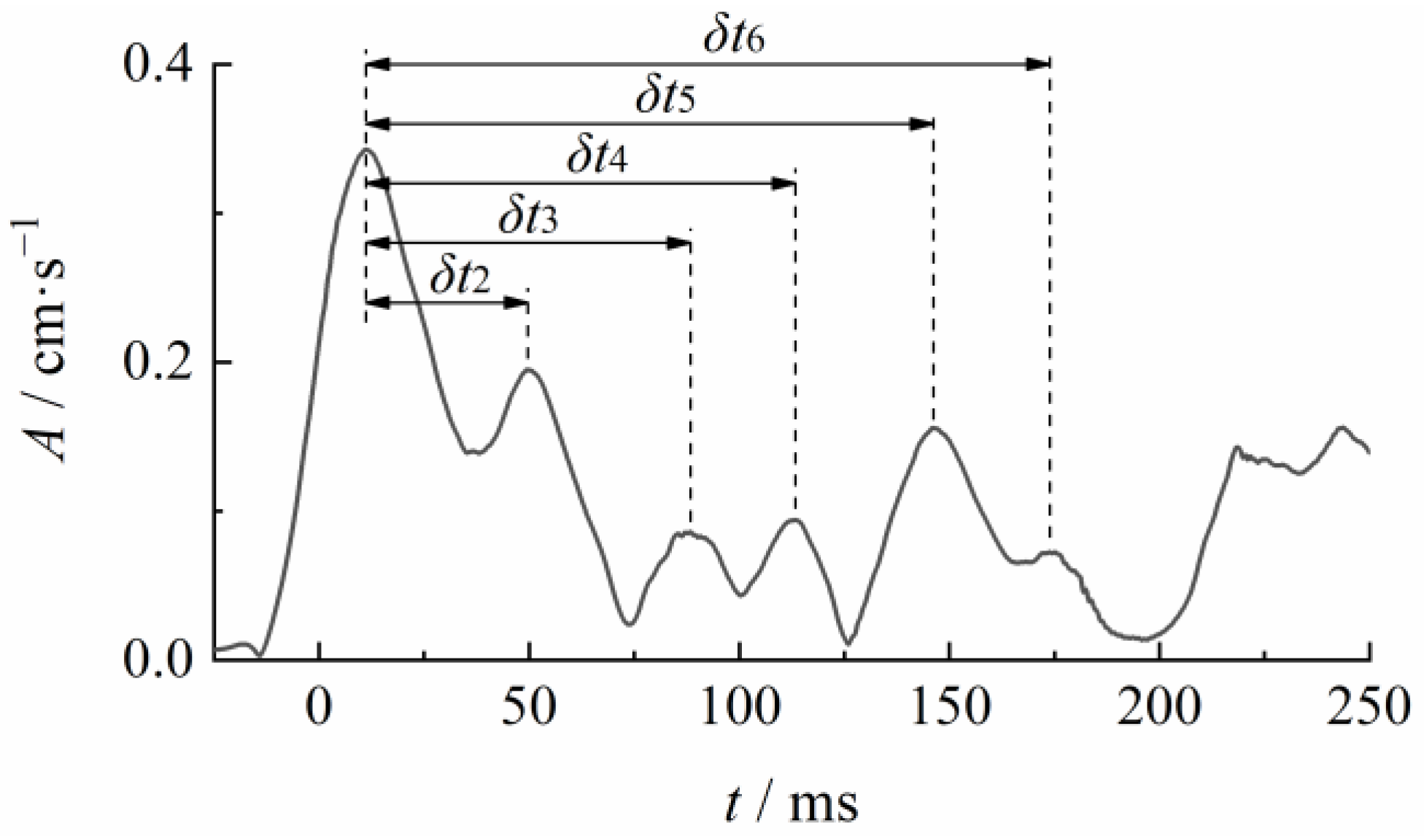
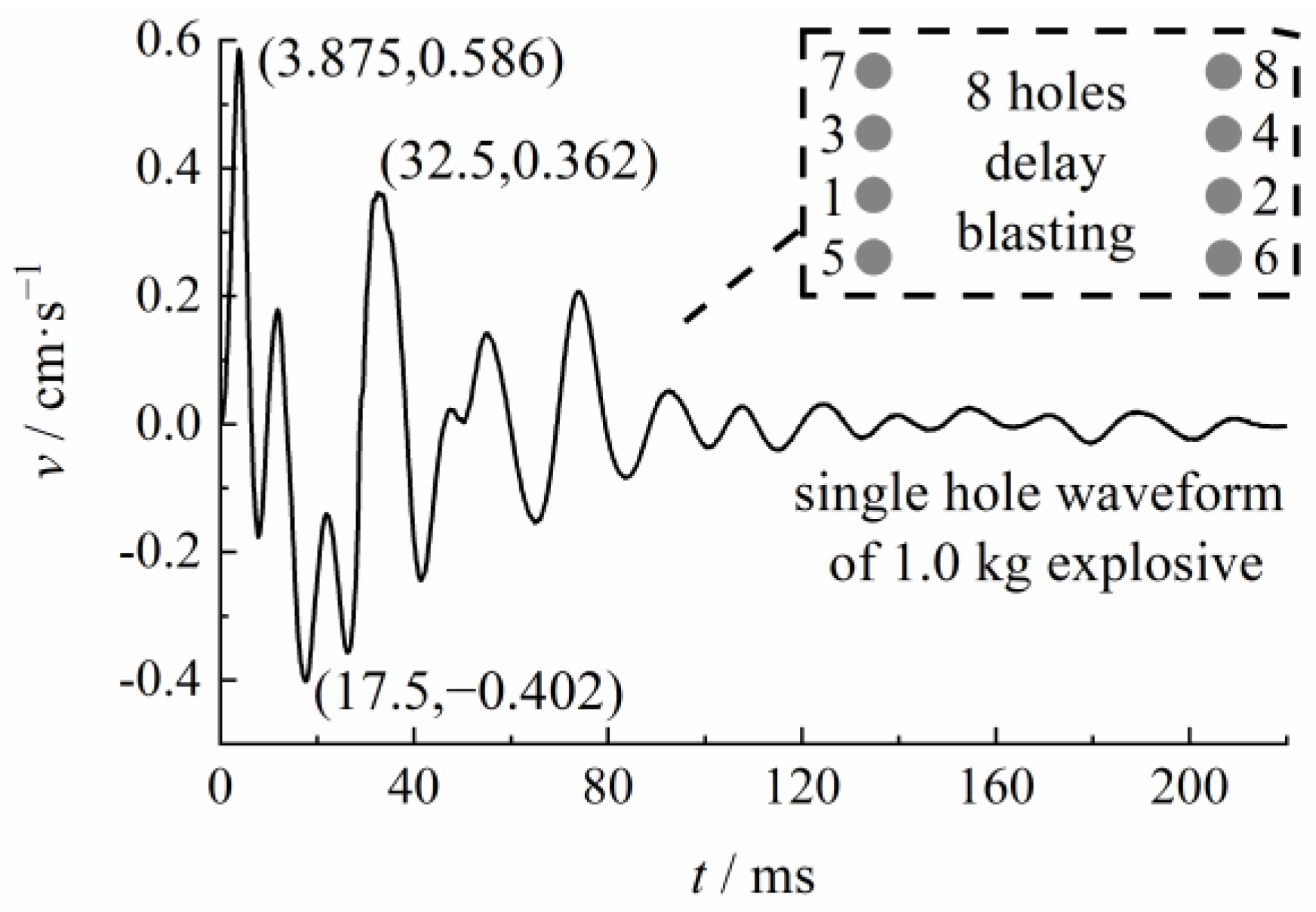
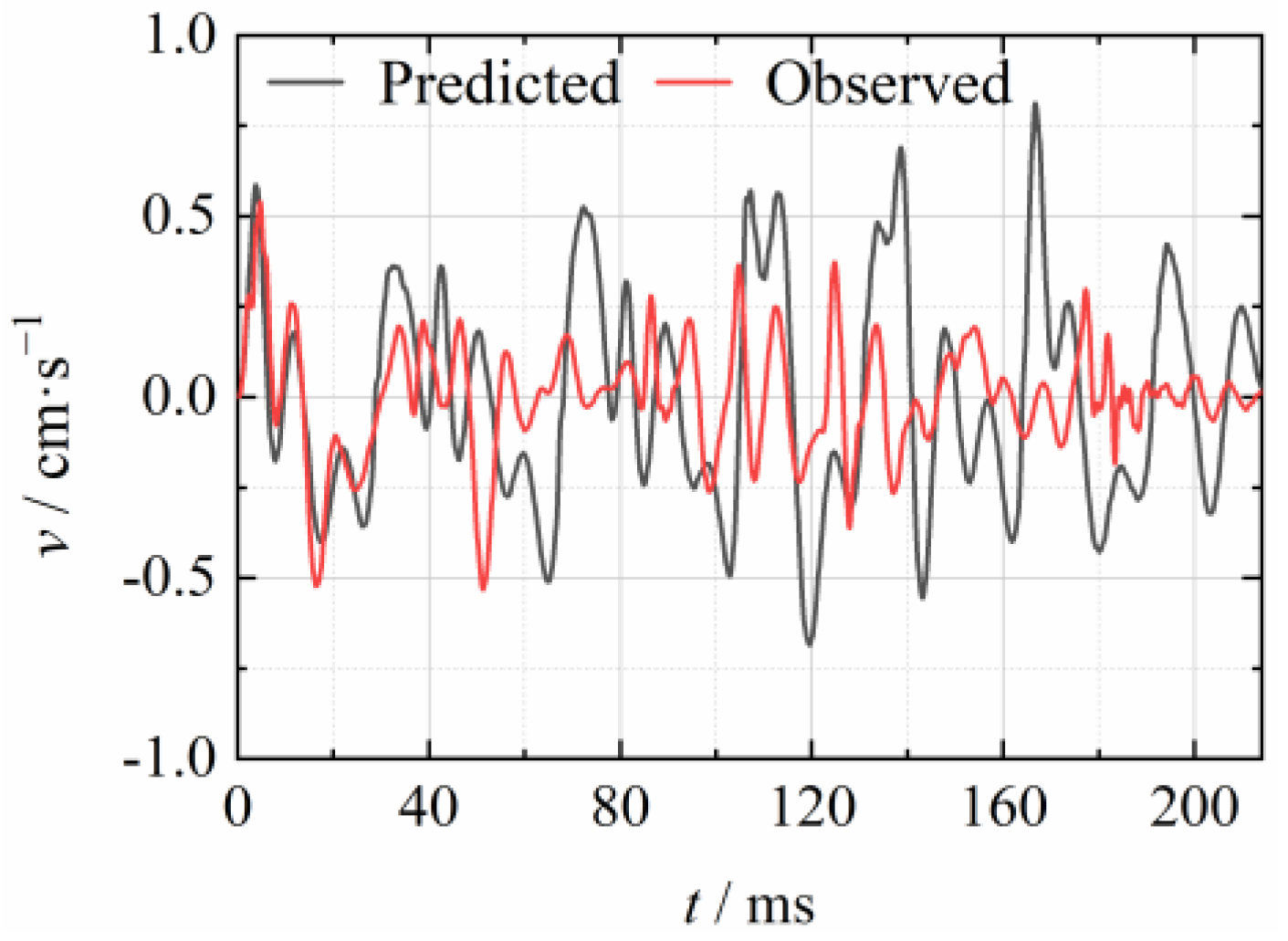


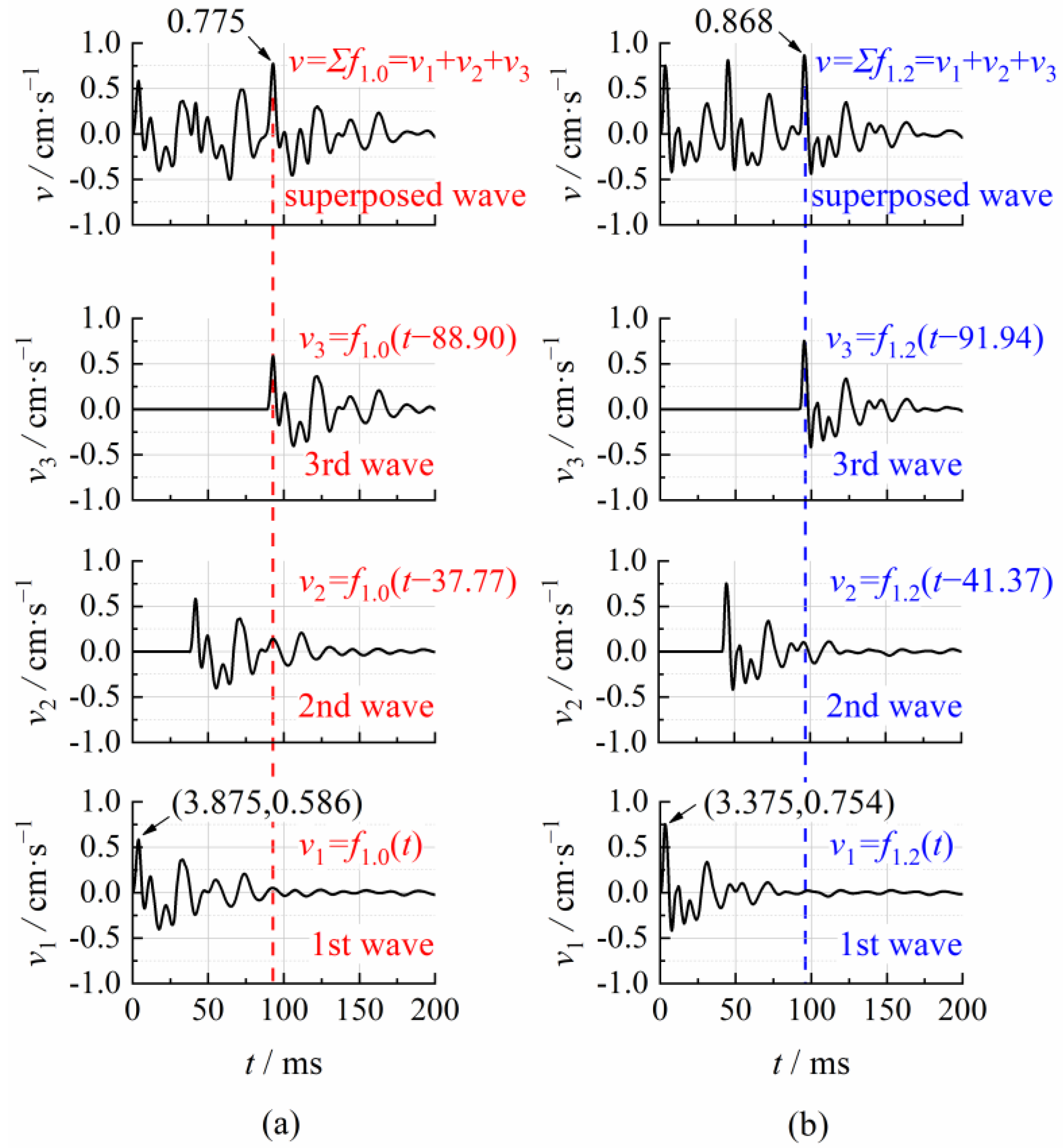
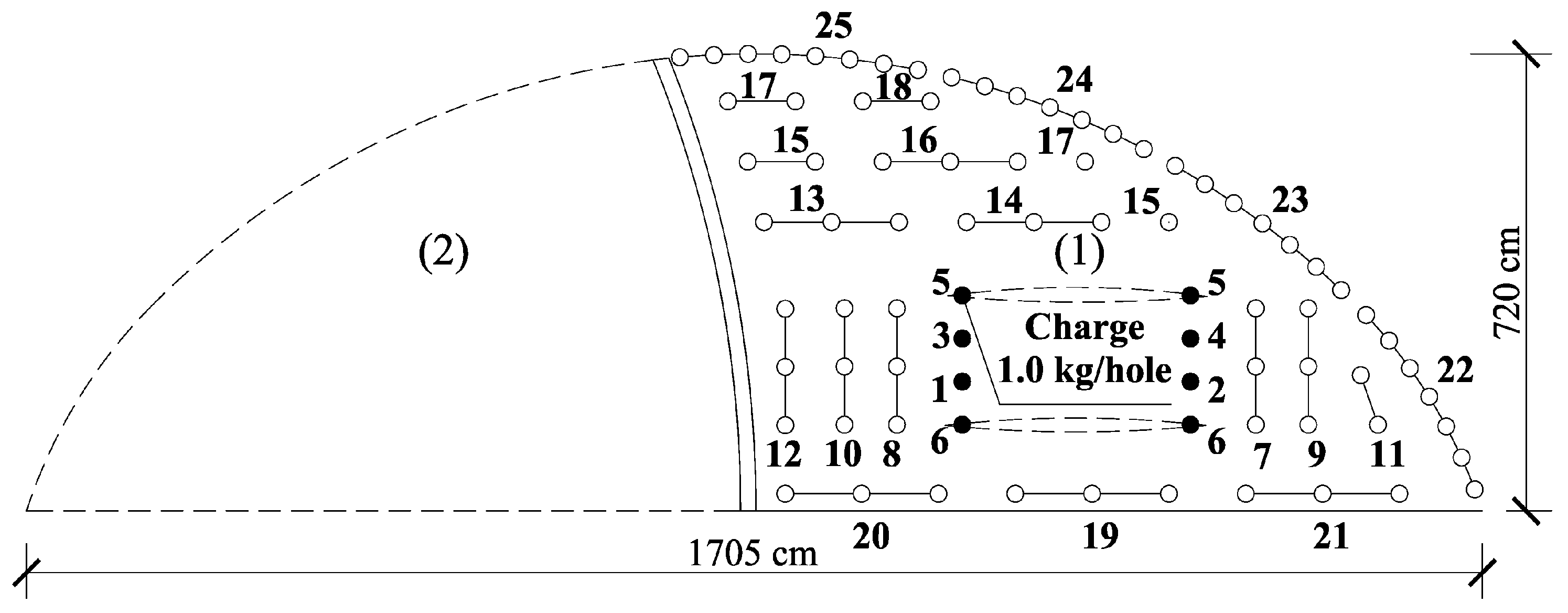
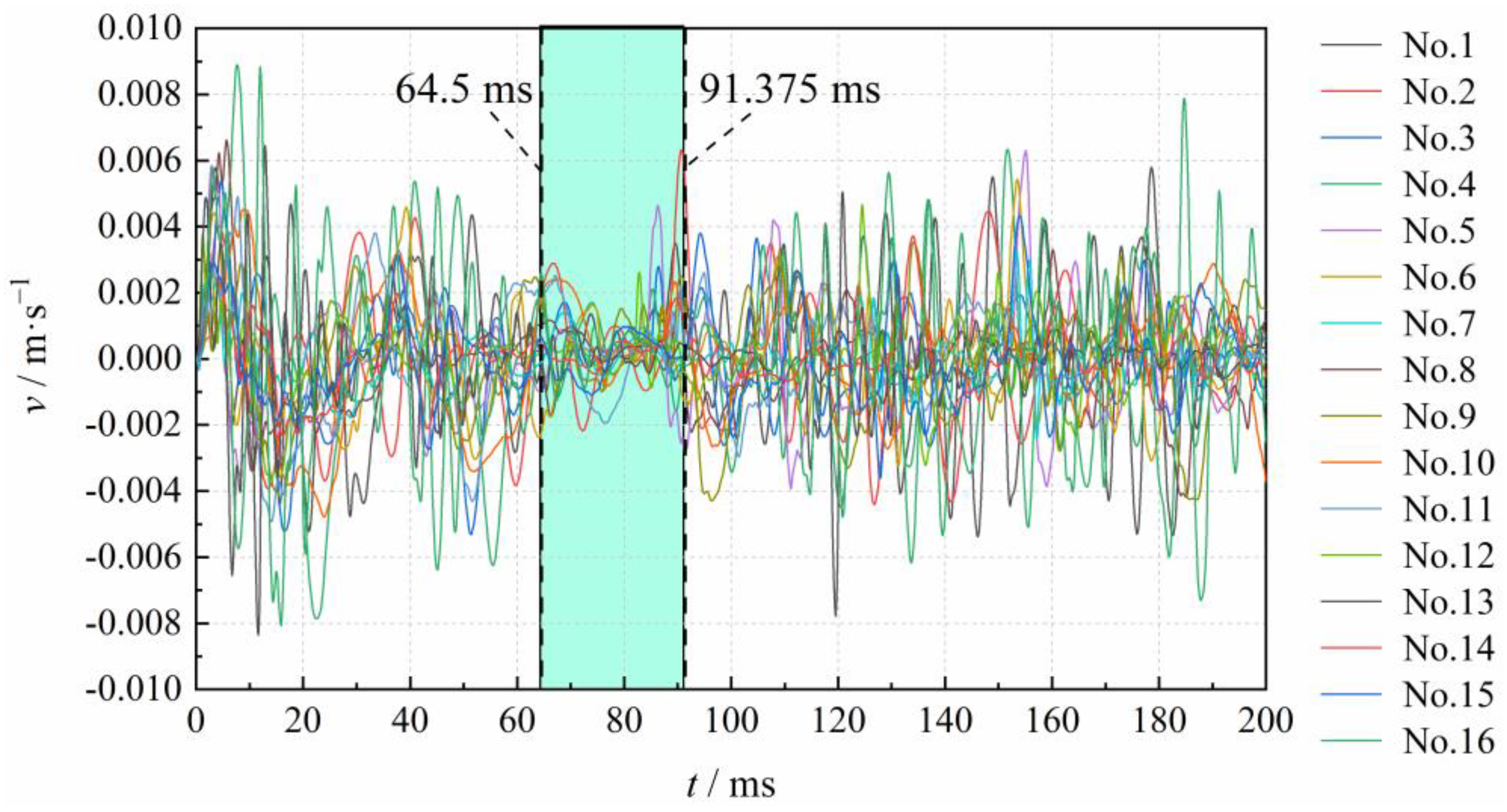
| No. | δ2/ms | δ3/ms | Peak of S″(t)|/cm·s−1 |
|---|---|---|---|
| 1 | 44.60 | 90.48 | 0.629 |
| 2 | 47.90 | 90.90 | 0.638 |
| … | … | … | … |
| 712 | 37.77 | 88.90 | 0.775 |
| … | … | … | … |
| 999 | 44.62 | 87.19 | 0.639 |
| 1000 | 38.06 | 89.70 | 0.769 |
| No. | δ2/ms | δ3/ms | Peak of|S″(t)|/cm·s−1 |
|---|---|---|---|
| 1 | 47.77 | 87.83 | 0.783 |
| 2 | 38.72 | 87.07 | 0.785 |
| … | … | … | … |
| 794 | 41.37 | 91.94 | 0.868 |
| … | … | … | … |
| 999 | 43.04 | 87.16 | 0.842 |
| 1000 | 46.00 | 90.93 | 0.803 |
Publisher’s Note: MDPI stays neutral with regard to jurisdictional claims in published maps and institutional affiliations. |
© 2022 by the authors. Licensee MDPI, Basel, Switzerland. This article is an open access article distributed under the terms and conditions of the Creative Commons Attribution (CC BY) license (https://creativecommons.org/licenses/by/4.0/).
Share and Cite
Wu, H.; Gong, M.; Zhao, Q.; Wu, X.; Liu, X. Vibration Energy Comparison Helps Identify Formation Time of New Free Surface in Urban Tunnel Blasting. Appl. Sci. 2022, 12, 10061. https://doi.org/10.3390/app121910061
Wu H, Gong M, Zhao Q, Wu X, Liu X. Vibration Energy Comparison Helps Identify Formation Time of New Free Surface in Urban Tunnel Blasting. Applied Sciences. 2022; 12(19):10061. https://doi.org/10.3390/app121910061
Chicago/Turabian StyleWu, Haojun, Min Gong, Qing Zhao, Xiaodong Wu, and Xiangyu Liu. 2022. "Vibration Energy Comparison Helps Identify Formation Time of New Free Surface in Urban Tunnel Blasting" Applied Sciences 12, no. 19: 10061. https://doi.org/10.3390/app121910061
APA StyleWu, H., Gong, M., Zhao, Q., Wu, X., & Liu, X. (2022). Vibration Energy Comparison Helps Identify Formation Time of New Free Surface in Urban Tunnel Blasting. Applied Sciences, 12(19), 10061. https://doi.org/10.3390/app121910061





